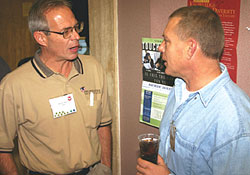
Sending that strong message were Rex Boynton and Pat Murphy from North American Technician Excellence (NATE), who supplied the group of instructors with passing rates of the NATE exams monitored since 1999.
"The passing rate for the installation core exam is 48 percent and 66 percent for the service core exam," noted Murphy.
"With the majority of the questions incorrectly answered relating to interpreting electrical diagrams, understanding basic electricity and multimeter usage is most important."
According to Murphy, electrical questions on all of the NATE exams are answered incorrectly more often than any other subject, followed by air distribution questions.
"Guess what subject has the most correct answers?" asked Murphy, before answering his own question: "Safe refrigerant handling."

"The three biggest weaknesses we see at Hussman from entry-level technicians are electrical troubleshooting, interpreting schematic diagrams, and understanding the function and operation of electrical controls," said Sullivan.
"What can instructors do? Introduce to your students and interpret a wide variety of schematic drawings, make sure the students understand motors and motor theory, teach them to follow manufacturer recommendations, make sure students have a thorough understanding of volts, amps, and ohms, and make sure they understand electric controls and electric control theory."
In Sullivan's estimation, manufacturers expect graduates "to perform basic job skills, such as soldering and applying manifold gauges; be EPA certified to handle refrigerants; perform basic installation tasks, such as setting and leveling a unit; perform preventive maintenance skills; be willing to continue to learn; be professional; and demonstrate strong electrical skills and knowledge."

Brown took time out of his presentation, titled "New Developments in Compressor Technology," to review the placement and operation of the internally mounted motor protector of the scroll compressor. Brown supplied the group with information on the components and operation of the new scroll compressors. The company's Ultra Tech Scroll is a two-stage, high-efficient compressor available in 2 tons to 5 tons.
According to Brown, the compressor starts at 65 percent capacity (first stage) and then activates the remaining 35 percent (second stage) when load demand requires. Meanwhile, the company's new Digital Scroll compressor is a 10-percent to 100-percent modulating compressor, said Brown, available in 4 hp to 6 hp - and soon to be available in 10 hp.

More Presentations
Jim Bergmann of Cuyahoga Valley Community College and Bill Spohn of Testo presented information on how to incorporate digital instrumentation into instructional programs to improve the learning retention for students.Their presentation, "Modern Instrumentation," displayed new digital technology connected to existing HVACR systems using sensors to record system information - such as suction pressure, superheat, subcooling, etc. - for extended times. The recorded data is designed to supply an instructor a graph-like visual aid when explaining the relations between temperature differences, pressures, superheat, subcooling, and other vital information necessary to evaluate system performance.
Meanwhile, Rob Dohse, senior training specialist from Carrier, introduced the technically advanced Infinity System in his presentation "Digital Controls for Residential Applications." The Infinity System is unique in that it does not use a thermostat, but a user interface. The advantage of the interface, said Dohse, is that it is capable of controlling the heating and cooling components, and it can also control accessories, such as a heat recovery ventilator/energy recovery ventilator (HRV/ERV), humidifier, and dehumidifier.
According to Dohse, the interface alerts the homeowner when maintenance is recommended for a UV light, humidifier pad, HRV/ERV, or air filter, and also advises the homeowner when service is required.
In another presentation, "The Latest in ECM Technology," Dr. Roger Becerra and Tim Neal of General Electric concentrated on the operation and uses of ECM motors, which are used in many HVACR systems.
An on-site ECM Trainer was available to help the group visualize the operation of the motor
at different static pressures. The presenters received a thankful applause when they informed the instructors that each would be sent the components to construct the trainer, at no cost.
The Invisible Service Technician (IST), winner of the 2005 AHR Expo Building Automation Innovation Award, was discussed and displayed by IST chief executive officer and president Mike Duty.
The IST is a remote monitoring and diagnostic device designed to detect developing problems before they cause failure in the customer's equipment. The monitor, which connects to the customer's phone line, consists of 10 sensors and six open sensor inputs, which are mounted to the equipment.
According to Duty, the system monitors multiple operating parameters and is designed to immediately notify the IST data center if a problem is detected. The online data center, in turn, alerts the servicing contractor and provides them with enough operating data to diagnose the developing problem without having to visit the customer's site.

Contractors May Be Invited In 2006
The workshop was kicked off with welcoming remarks from ARI president Woody Sutton, who was joined by Steve Yurek, ARI's vice president for policy and public affairs, and Ray Mach, director of education for ARI. Mach noted that in addition to ARI, Refrigeration Service Engineers Society (RSES), Plumbing-Heating-Cooling Contractors - National Association (PHCC), and Air Conditioning Contractors of America (ACCA) will partner to sponsor the conference in 2006.In an attempt to continue improving HVACR education, the proposal for next year's conference may include invitations to contractors. "The addition of contractors to the conference will allow the contractors to get a much better insight into what instructors are trying to do," said Mach.
"And, it also gives the instructors a much better insight into what contractors are looking for in entry-level HVACR technicians.
"People who attend the conference will still receive a Certificate for Continuing Education and still be able to take the NATE and ICE exam at no cost, but now we will also offer free RSES testing for those who are RSES members."
The workshop concluded with the participants having the option of taking free ICE and NATE tests.
"One of the great things about the workshop is that no one goes home empty handed," said Mach.
Publication date: 04/18/2005

Report Abusive Comment